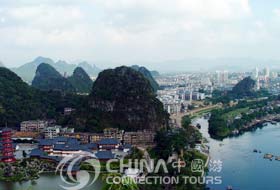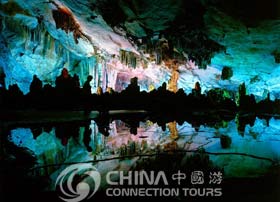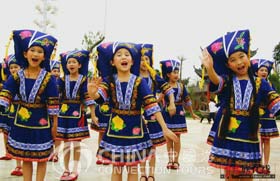
 Guilin is South China's shining pearl, with verdant mountains, clear rivers, and magnificent crags and fantastic caverns. The scenery of Guilin has been called the finest under heaven. Guilin enjoys a mild climate with sufficient rainfall. The mountains rise abruptly from the ground as if some monster used a stick to push them up from below. The limestone has weathered and eroded into fantastic stone forests, and peaks, while underground streams have carved caves and grottos.
Guilin is South China's shining pearl, with verdant mountains, clear rivers, and magnificent crags and fantastic caverns. The scenery of Guilin has been called the finest under heaven. Guilin enjoys a mild climate with sufficient rainfall. The mountains rise abruptly from the ground as if some monster used a stick to push them up from below. The limestone has weathered and eroded into fantastic stone forests, and peaks, while underground streams have carved caves and grottos.
There are more than 30 noted scenic spots within the Guilin area. Elephant Trunk Hill, the city's symbol, named because it looks like an elephant sipping water from the Lijiang River with its trunk, the Piled Festoon Hill where the exposed broken rock strata on its sides look like piles of  ruffles, and the Crescent Hill that is named for the moon-shaped cave opening in its side are just three among many.
ruffles, and the Crescent Hill that is named for the moon-shaped cave opening in its side are just three among many.
There are two fantastic caves in the area--- the seven-star-rock cave, which gets its name from the arrangement of the surrounding peaks that resemble the pattern of the stars of the Great Bear constellation, and Reed-Flute Cave, named after the reeds growing around the cave mouth. They both contain spectacular stalactites and stalagmites.
Guilin and the surrounding area is home to many ethnic minorities, such as Zhuang, Yao, Hui, Miao, Mulao, Maonan and Dong enriches the cultural life of the city. Each minority has its own unique customs and festivals. Northwest of Guilin are the towns of Longsheng and Sanjiang, where a mixture of  Dong, Zhuang, Yao, and Miao minority people lives. They tend to be very friendly and may offer to be your guide and possibly invite you into their homes for a meal and an overnight stay.
Dong, Zhuang, Yao, and Miao minority people lives. They tend to be very friendly and may offer to be your guide and possibly invite you into their homes for a meal and an overnight stay.
Guilin is a well-developed tourist center with convenient transportation, communication and accommodation facilities. You can enter Guilin by air, train or bus and get around on free shuttle buses. Accommodations range from luxury hotels to hostels. You can eat at splendid restaurants or grab a local snack, but whatever you do, you can be sure that the locals are determined to meet your needs.
As a tourist destination second to none in China, Guilin will surely continue to attract ever more visitors from home and abroad.
Besides, Guilin has a various minorities which has different cultures and customs. Many ethnic minorities represented here that include the Zhuang, Yao, Hui, Miao, Mulao, Maonan and Dong enriches the cultural life of the city. These groups all have colorful customs and mostly rural lifestyles. Each minority has its own unique customs and festivals and this means that they are much more abundant here than in many other places elsewhere in China. Northwest of Guilin are the towns of Longsheng and Sanjiang, where you can find mixtures of Dong, Zhuang, Yao, and Miao minority villages. These people tend to be very friendly and may offer to be your guide and possibly invite you into their home for a meal and an overnight stay.
Guilin is a well-developed tourist center with convenient transportation, communication and accommodation facilities. You can enter Guilin by air, by train or by bus and get around on free buses. From luxury hotels to hostels, from splendid restaurants to local snacks, you are sure to find that your needs will be met beyond your expectations.
Guilin was first established by Emperor Qinshihuang (214 BC) as the Guilin Shire. It was located on the Guixiang "Corridor", which was an important passage connecting Zhongyuan and Lingnan. During the Three-Kingdom period, the Wu Kingdom built up Shi'an Shire here, and from then on Guilin has come to be a political and transition center. Till Tang Dynasty, Guilin had become a relatively big city. In Song Dynasty Guilin was the capital of Guangnanxilu, which governed Guangxi and Hainan Island. In Ming Dynasty, Guilin was also the seat of Jingjiang Prince Mansion. The revolutionary pioneer Sun Yat-san had his residence set up here and directed the Northward expedition. In 1940 Guilin was reset as a city of Guangxi Province.
Guilin is the world-famous tourists’ city, situated at the Xianggui (Guangxi and Hunan) corridor south tip, the east longitude 109°36 ' to 111°29 ', the north latitude 24°15 ' to 26°23 ', and its average elevation is 150 meters. Guilin has a total area of 27,800 square kilometers.

